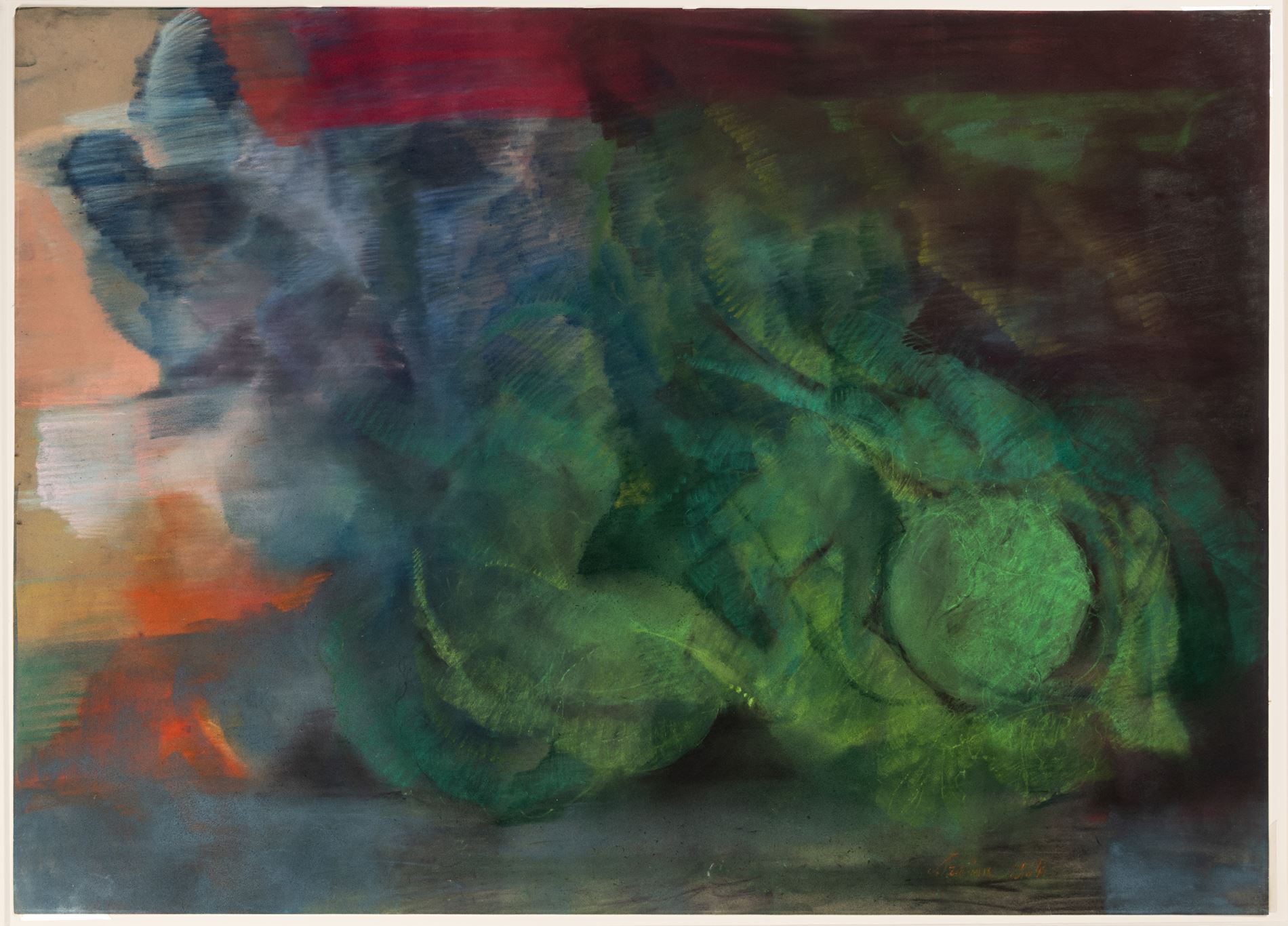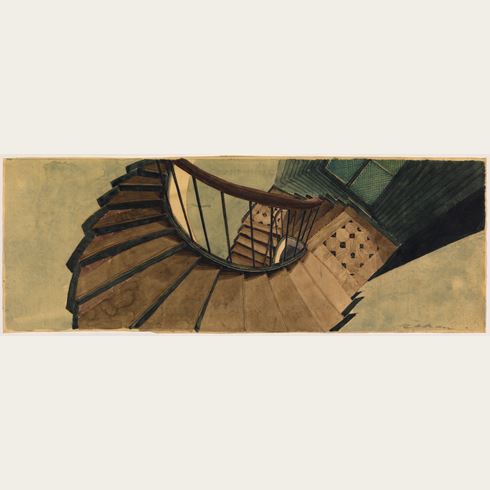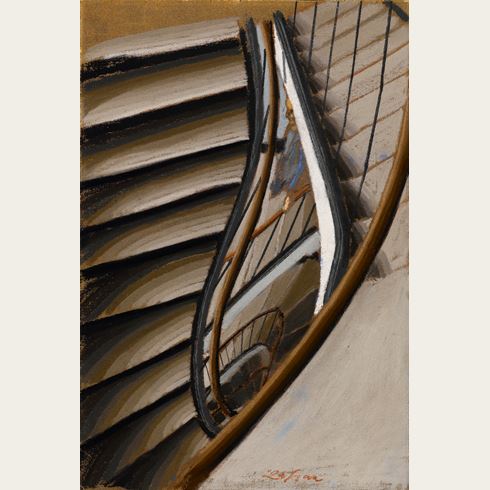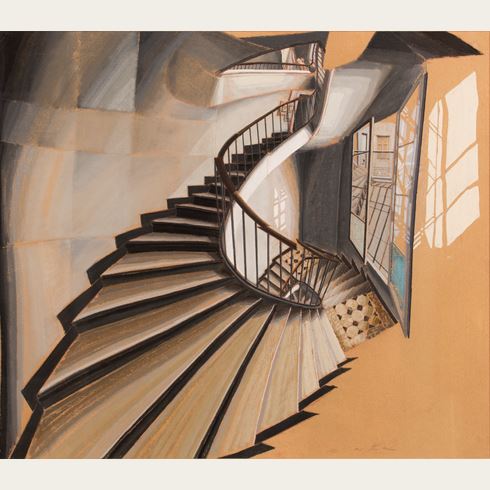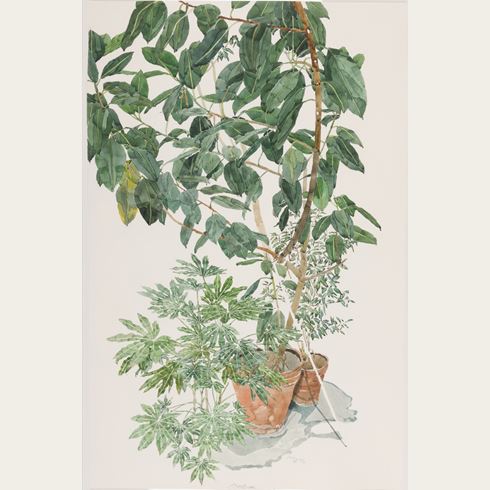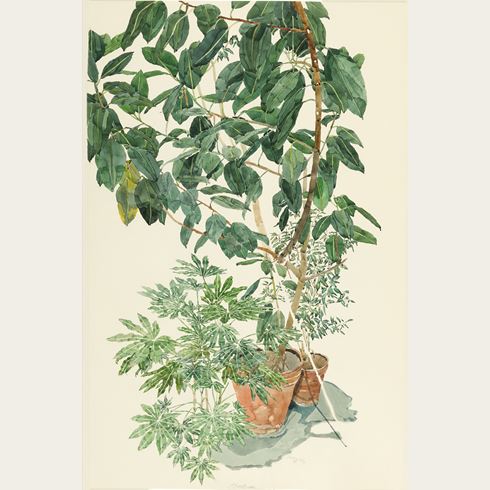Sam SZAFRAN
(Paris 1934 - Paris 2019)
Untitled (Cabbages)
Sold
Pastel on light brown paper, stamped PAPIER VELOURS / pour le Pastel / MADE IN FRANCE in black ink on the verso.
Signed and dated Szafran 1964 in red chalk at the lower right.
Inscribed Sam Szafran 1963 / 1 sentier des alains choeu[?] / l’entrepot a choues / 1 in blue ink on a label pasted onto the verso.
725 x 1003 mm. (28 1/2 x 39 1/2 in.)
Signed and dated Szafran 1964 in red chalk at the lower right.
Inscribed Sam Szafran 1963 / 1 sentier des alains choeu[?] / l’entrepot a choues / 1 in blue ink on a label pasted onto the verso.
725 x 1003 mm. (28 1/2 x 39 1/2 in.)
Between 1958 and 1965 Sam Szafran produced one of his first series of works in pastel, which also marked his turn from abstraction to figuration; a group of large-scale works depicting heads of cabbages. The vegetable reminded him of his youth, and in particular of trips with his father to the market in Paris, and it was also likely a staple of his diet during the penurious years of his early career. As one scholar has noted, ‘the artist executed numerous variations on heads of cabbage, a vegetable familiar to him from his childhood…In 1961-62 the nourishing and cheap post-war vegetable became the young artist’s study object of preference.’
In his first week of depicting cabbages in pastel, Szafran created eight large works, and he continued to work obsessively on the theme for the next few years. Early on, as he recalled, ‘I was seeing a cabbage, but drawing something that wasn’t a cabbage. One day I had the idea of looking at a cabbage through a thread-counter, and I realized that, between staring at something and simply looking at it, there was a world of difference. Through my thread-counter, I wasn’t seeing a cabbage, I was inside it, in the middle of the veins and the giant pigmentation. My eye did this quite naturally when I was looking at my cabbages, but no longer when I was looking at my sheet of paper. By dint of staring at the cabbages, my eye had developed like a sportsman’s muscle; it had become a thread-counter in its own right. But just as I was able to stare at the cabbages with my eyes, I still had to fix them on my paper. So everything changed for me. In the street, I no longer saw things in the same way. I finally understood the reasons for my determination to master the pastel technique, which, unconsciously, my eyes had already perceived. My pastels appeared to me in a new light. Through them, I could see the decomposition of colours. In oil painting, you take elementary or complementary colours and mix them together. You can’t mix pastel colours.’
As one writer has quoted the artist, referring to this period of his career, when he first began working in the medium of pastel: ‘If I had known what I was letting myself in for, admits Szafran, I probably would never have bought my first box of pastels. I found myself, in 1958, fresh from abstract art, in front of these little multicolored sticks like a poverty-stricken child in a Belgian or Swiss delicatessen amidst an abundance of candy and cakes, and I seized them without even thinking. For twenty years I threw myself into this technique, because I was incapable of mastering it.’
In his first week of depicting cabbages in pastel, Szafran created eight large works, and he continued to work obsessively on the theme for the next few years. Early on, as he recalled, ‘I was seeing a cabbage, but drawing something that wasn’t a cabbage. One day I had the idea of looking at a cabbage through a thread-counter, and I realized that, between staring at something and simply looking at it, there was a world of difference. Through my thread-counter, I wasn’t seeing a cabbage, I was inside it, in the middle of the veins and the giant pigmentation. My eye did this quite naturally when I was looking at my cabbages, but no longer when I was looking at my sheet of paper. By dint of staring at the cabbages, my eye had developed like a sportsman’s muscle; it had become a thread-counter in its own right. But just as I was able to stare at the cabbages with my eyes, I still had to fix them on my paper. So everything changed for me. In the street, I no longer saw things in the same way. I finally understood the reasons for my determination to master the pastel technique, which, unconsciously, my eyes had already perceived. My pastels appeared to me in a new light. Through them, I could see the decomposition of colours. In oil painting, you take elementary or complementary colours and mix them together. You can’t mix pastel colours.’
As one writer has quoted the artist, referring to this period of his career, when he first began working in the medium of pastel: ‘If I had known what I was letting myself in for, admits Szafran, I probably would never have bought my first box of pastels. I found myself, in 1958, fresh from abstract art, in front of these little multicolored sticks like a poverty-stricken child in a Belgian or Swiss delicatessen amidst an abundance of candy and cakes, and I seized them without even thinking. For twenty years I threw myself into this technique, because I was incapable of mastering it.’
Born Samuel Berger in Paris in 1934 to Polish immigrants, Sam Szafran took the maiden name of his mother when he began to sign his works in the 1960s. Although he was briefly enrolled at the Académie de la Grande-Chaumière in Paris in the mid-1950s, Szafran was largely self-taught as an artist. He exhibited at the Salon des Indépendants in 1957 and two years later at the Salon des Réalités Nouvelles. While his earliest work was based in abstraction, from around 1960 onwards he began to depict representational subjects, drawn in pastel, charcoal or watercolour. Content with studying a limited range of themes - notably studio interiors, staircases and plant forms - Szafran produced numerous drawings, each characterized by a very skillful handling of the medium and an abiding interest in perspectival effects. From 1965 Szafran’s work was exhibited extensively in France, and also in Switzerland, but only rarely elsewhere. He contributed to the Nouvelle Subjectivité exhibitions curated by Jean Clair in Paris in 1976 and in Brussels in 1979. A retrospective exhibition of drawings, pastels, watercolours and sculptures was held at the Fondation Pierre Gianadda in Martigny, Switzerland, in 1999-2000, and was followed by further retrospectives at the Max Ernst Museum in Brühl in 2010-2011 and the Fondation Gianadda in 2013. Following Szafran’s death in 2019, a large commemorative exhibition at the Musée de l’Orangerie in Paris in 2022-2023 drew some 330,000 visitors.
A permanent gallery devoted to Szafran’s work was established in 2015 at the Fondation Gianadda in Martigny, while other works by the artist are today in the collections of the Metropolitan Museum of Art and the Museum of Modern Art in New York, the Centre National d’Art Contemporain, the Musée d’Orsay and the Musée d’Art Moderne in Paris, the Hirshhorn Museum and Sculpture Garden in Washington, D.C., and elsewhere.
A permanent gallery devoted to Szafran’s work was established in 2015 at the Fondation Gianadda in Martigny, while other works by the artist are today in the collections of the Metropolitan Museum of Art and the Museum of Modern Art in New York, the Centre National d’Art Contemporain, the Musée d’Orsay and the Musée d’Art Moderne in Paris, the Hirshhorn Museum and Sculpture Garden in Washington, D.C., and elsewhere.
Provenance
The studio of the artist, Paris
Acquired directly from the artist by a private collection, California
Thence by descent.
Acquired directly from the artist by a private collection, California
Thence by descent.

